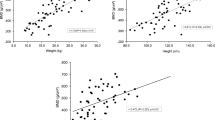Abstract
Purpose
We aimed to evaluate the relationship between bone mineral density (BMD) disorders and possible risk factors in patients with epilepsy only (EO), cerebral palsy only (CPO), and cerebral palsy–epilepsy (CP + E).
Methods
A total of 122 patients [EO (n = 54), CPO (n = 30), CP + E (n = 38)] and 30 healthy children were evaluated. BMD was only measured in patient groups, not in control subjects. BMD of lumbar vertebrae was determined by dual energy X-ray absorptiometry (DXA). An abnormal BMD was defined as low or low normal BMD.
Results
Low BMD rate in EO, CPO, and CP + E group was 3.7, 50, and 39.5 %, respectively. Abnormal BMD values were significantly related to inadequate dietary Ca intake (p = 0.017), severe intellectual disability (p < 0.001), and immobility (p = 0.018). In multivariate regression analysis, the risk of abnormal BMD was higher (3.9-fold) in patients not able to walk independently than the others (p = 0.029). However, serum Ca−Vitamin D levels, insufficient exposure to sunlight, low BMI, and use of AED were not correlated with abnormal BMD.
Conclusion
Abnormal BMD is a common problem in patients with CP and CP + E. Abnormal BMD was related to the severity of CP, but not to vitamin D levels or AED treatment.

Similar content being viewed by others
References
Baroncelli GI, Bertelloni S, Sodini F, Saggese G (2005) Osteoporosis in children and adolescents: etiology and management. Paediatr Drugs 7:295–323
Goksen D, Darcan S, Coker M, Kose T (2006) Bone mineral density of healthy Turkish children and adolescents. J Clin Densitom 9:84–90
Verrotti A, Coppola G, Parisi P et al (2010) Bone and calcium metabolism and antiepileptic drugs. Clin Neurol Neurosurg 112:1–10
Sheth RD (2004) Bone health in pediatric epilepsy. Epilepsy Behav 5:S30–S35
Hough JP, Boyd RN, Keating JL (2010) Systematic review of interventions for low bone mineral density in children with cerebral palsy. Pediatrics 125:670–678
Nettekoven S, Ströhle A, Trunz B et al (2008) Effects of antiepileptic drug therapy on vitamin D status and biochemical markers of bone turnover in children with epilepsy. Eur J Pediatr 167:1369–1377
Cansu A, Yeşilkaya E, Serdaroğlu A et al (2008) Evaluation of bone turnover in epileptic children using oxcarbazepine. Pediatr Neurol 39:266–271
Henderson RC, Kairalla J, Abbas A, Stevenson RD (2004) Predicting low bone density in children and young adults with quadriplegic cerebral palsy. Dev Med Child Neurol 46:416–419
Coppola G, Fortunato D, Auricchio G (2009) Bone mineral density in children, adolescents, and young adult with epilepsy. Epilepsia 50:2140–2146
Coppola G, Fortunato D, Mainolfi C et al (2012) Bone mineral density in a population of children and adolescents with cerebral palsy and mental retardation with or without epilepsy. Epilepsia 53:2172–2177
Holick MF (2004) Sunlight and vitamin D for bone health and prevention of autoimmune diseases, cancers, and cardiovascular disease. Am J Clin Nutr 80:1678S–1688S
Gomez F, Ramos Galvan R, Frenk S et al (2000) Mortality in second and third degree malnutrition. 1956. Bull World Health Organ 78:1275–1280
Ross AC, Taylor CL, Yaktine AL, Del Valle HB (2011) Dietary reference intakes for calcium and vitamin D. Institute of Medicine of the National Academies. National Academies Press (US), Washington (DC)
Skeletal health assessment in children and adolescents (males and females ages 5–19), www.iscd.org.
Shaw NJ (2008) Management of osteoporosis in children. Eur J Endocrinol 159(Suppl 1):S33–S39
Babayigit A, Dirik E, Bober E, Cakmakci H (2006) Adverse effects of antiepileptic drugs on bone mineral density. Pediatr Neurol 35:177–181
Tsukahara H, Kimura K, Todoroki Y et al (2002) Bone mineral status in ambulatory pediatric patients on long-term antiepileptic drug therapy. Pediatr Int 44:247–253
Misra A, Aggarwal A, Singh O, Sharma S (2010) Effect of carbamazepine therapy on vitamin D and parathormone in epileptic children. Pediatr Neurol 43:320–324
Baek JH, Seo YH, Kim GH, Kim MK, Eun BL (2014) Vitamin D levels in children and adolescents with antiepileptic drug treatment. Yonsei Med J 55:417–421
Harijan P, Khan A, Hussain N (2013) Vitamin D deficiency in children with epilepsy: do we need to detect and treat it? J Pediatr Neurosci 8:5–10
Kafali G, Erselcan T, Tanzer F (1999) Effect of antiepileptic drugs on bone mineral density in children between ages 6 and 12 years. Clin Pediatr 38:93–98
Henderson RC, Lin PP, Greene WB (1995) Bone-mineral density in children and adolescents who have spastic cerebral palsy. Bone Joint Surg Am 11:1671–1681
Henderson RC, Lark RK, Gurka MJ et al (2002) Bone density and metabolism in children and adolescents with moderate to severe cerebral palsy. Pediatrics 110:e5
Stevenson RD, Hayes RP, Cater LV, Blackman JA (1994) Clinical correlates of linear growth in children with cerebral palsy. Dev Med Child Neurol 36:35–42
Benigni I, Devos P, Rofidal T, Seguy D (2011) The CP-MST, a malnutrition screening tool for institutionalized adult cerebral palsy patients. Clin Nutr 30:769–773
Hurvitz EA, Green LB, Hornyak JE et al (2008) Body mass index measures in children with cerebral palsy related to gross motor function classification: a clinic- based study. Am J Phys Med Rehabil 87:395–403
Mergler S, Evenhuis HM, Boot AM, De Man SA, Bindels-De Heus KG, Huijbers WA, Penning C (2009) Epidemiology of low bone density and fractures in children with severe cerebral palsy: a systematic review. Dev Med Child Neurol 51:773–778
Finbråten AK, Syversen U, Skranes J, Andersen GL, Stevenson RD, Vik T (2015) Bone mineral density and vitamin D status in ambulatory and non-ambulatory children with cerebral palsy. Osteoporos Int 26(1):141–150
Acknowledgments
We would like to thank to Yusuf Afacan and Ahmet Anık for critical review of our manuscript.
Author information
Authors and Affiliations
Corresponding author
Ethics declarations
Conflict of interest
None.
Rights and permissions
About this article
Cite this article
Tosun, A., Erisen Karaca, S., Unuvar, T. et al. Bone mineral density and vitamin D status in children with epilepsy, cerebral palsy, and cerebral palsy with epilepsy. Childs Nerv Syst 33, 153–158 (2017). https://doi.org/10.1007/s00381-016-3258-0
Received:
Accepted:
Published:
Issue Date:
DOI: https://doi.org/10.1007/s00381-016-3258-0




